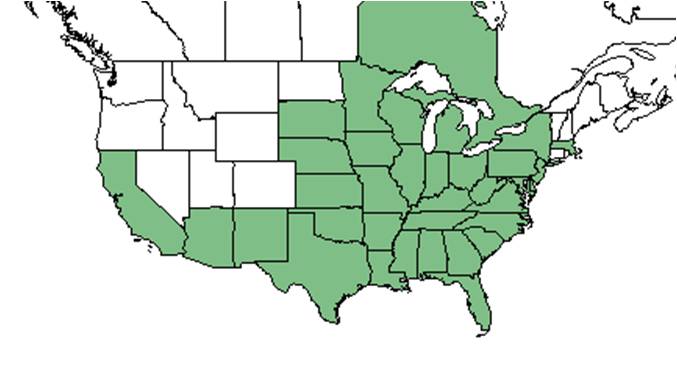Difference between revisions of "Eclipta prostrata"
KatieMccoy (talk | contribs) |
KatieMccoy (talk | contribs) |
||
| Line 27: | Line 27: | ||
==Ecology== | ==Ecology== | ||
===Habitat=== <!--Natural communities, human disturbed habitats, topography, hydrology, soils, light, fire regime requirements for removal of competition, etc.--> | ===Habitat=== <!--Natural communities, human disturbed habitats, topography, hydrology, soils, light, fire regime requirements for removal of competition, etc.--> | ||
| + | ''Eclipta prostata'' can be found in shallow water in shaded ''Acer''-''Nyssa''-''Taxodium'' swamps; cypress depression swamps; marsh edges; lake shores; river banks; brackish marshes; seepage areas in calcareous talus; moist sandy-peaty clearings of ''Baccharis'' flats; sandy loam of coastal hammocks; pine flatwoods; and river floodplains (FSU Herbarium). It has been found to occur in human impacted areas such as gardens, holding ponds, and drainage ditches. Substrate types include sandy peat, loamy sand and sandy loam soils (FSU Herbarium). Associated species include ''Typha, Erechtites, Ludwigia, Juncus, Mitreola, Fuirena'', and ''Rhynchospora'' (FSU Herbarium). | ||
| + | |||
===Phenology=== <!--Timing off flowering, fruiting, seed dispersal, and environmental triggers. Cite PanFlora website if appropriate: http://www.gilnelson.com/PanFlora/ --> | ===Phenology=== <!--Timing off flowering, fruiting, seed dispersal, and environmental triggers. Cite PanFlora website if appropriate: http://www.gilnelson.com/PanFlora/ --> | ||
===Seed dispersal=== | ===Seed dispersal=== | ||
Revision as of 18:28, 2 November 2015
| Eclipta prostrata | |
|---|---|
Error creating thumbnail: Unable to save thumbnail to destination
| |
| Scientific classification | |
| Kingdom: | Plantae |
| Division: | Magnoliophyta - Flowering plants |
| Class: | Magnoliopsida - Dicotyledons |
| Order: | Asterales |
| Family: | Asteraceae ⁄ Compositae |
| Genus: | Eclipta |
| Species: | E. prostrata |
| Binomial name | |
| Eclipta prostrata (L.) L. | |

| |
| Natural range of Eclipta prostrata from USDA NRCS Plants Database. | |
Common name: false daisy
Contents
Taxonomic notes
Description
A description of Eclipta prostrata is provided in The Flora of North America.
Distribution
Ecology
Habitat
Eclipta prostata can be found in shallow water in shaded Acer-Nyssa-Taxodium swamps; cypress depression swamps; marsh edges; lake shores; river banks; brackish marshes; seepage areas in calcareous talus; moist sandy-peaty clearings of Baccharis flats; sandy loam of coastal hammocks; pine flatwoods; and river floodplains (FSU Herbarium). It has been found to occur in human impacted areas such as gardens, holding ponds, and drainage ditches. Substrate types include sandy peat, loamy sand and sandy loam soils (FSU Herbarium). Associated species include Typha, Erechtites, Ludwigia, Juncus, Mitreola, Fuirena, and Rhynchospora (FSU Herbarium).
Phenology
Seed dispersal
Seed bank and germination
Fire ecology
Pollination
The following Hymenoptera families and species were observed visiting flowers of Eclipta prostrata at Archbold Biological Station (Deyrup 2015):
Colletidae: Hylaeus confluens
Halictidae: Halictus poeyi, Lasioglossum placidensis, L. puteulanum, L. tamiamensis
Sphecidae: Cerceris tolteca, Ectemnius rufipes ais
Vespidae: Parancistrocerus perennis anacardivora, P. salcularis rufulus, Stenodynerus fundatiformis
Use by animals
Diseases and parasites
Conservation and Management
Cultivation and restoration
Photo Gallery
References and notes
Deyrup, M.A. and N.D. 2015. Database of observations of Hymenoptera visitations to flowers of plants on Archbold Biological Station, Florida, USA.